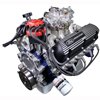Engine build : So the reason I ask about engine rev range use is this. If you intend to stress the engine with revs. Even if only once in a while then it needs to be balanced dynamically. That means all the rods, pistons, and ring packages need to be matched weight each and then assembled on the rods that also have been matched and then checked for equal weight as a unit. The crank, dampener, and flywheel need to be balanced as a unit also and every bearing clearance needs to be measured with mics, not plastiguage.
Production engines are matched to a standard weight +/- how much the builder thinks will work and not spend a lot of labor. Pistons and rods are chosen to fit in a weight range not equally matched. Cranks are balanced to a standard equal to the production goal and not with the dampener and flywheel down to as close to zero as possible. All this will matter if you run the motor on track or at sustained high revs, even a few times. The block needs to be line bored and the cylinders need to be at least checked for taper and roundness. A check for deck surface squareness should be done as well. Also, check and see how much the block has been bored. Some do .30 over and others do .40. .30 gets you one more bore should you ever need it.
Crate motors are not balanced. They are close enough for a street motor.......usually.......Engine builders cannot afford to spend the labor to do so. They are however a good way to get all the parts. Take it out of the crate, send it to an GOOD engine builder, and tell him to put it back together balanced and clearanced correctly. You will want the build sheet with all the measurements on it. This is not cheap but much less than buying all the parts separately, doing all the machine work, and then assembling it. Nearly everything can be reused except the gasket set.
Now you have a really, really good motor that can take what you throw at it within the parts design envelope for a very long time.
Headers: I think an RCR GT40 will accommodate a 351W without issues, 351s are taller than a 302 and the headers usually will not interchange. So this is a consideration. Especially if they are a cross-over type. A 351W will make about 50-70 hp more than a 302 of the same specification and at the same cost as a 302. I like them for street cars, especially because you can build a pretty low-spec motor and it will still make 375Hp all day long forever. This will be a hyd roller cam 10 to 1 pump gas motor with a Holley on top. 400 hp is also easy with an engine like this (just a bit more cam) and it will run on pump gas. It will not need an expensive GRBX, clutch, cv joints, axles, stub shafts, wheel bearings on and on.
Gear ratio selection: Gearbox specs. Here's where the money you same on the engine will be put to use. First, the GRBX needs to be able to live with the torque the motor makes plus about 20-25% but not less than 400 ft/lbs. This will put you in the Porsche G50 range as well at others.
Gears: Don't spend a lot of time worrying about a low 1st. They can be useful, in stop-and-go traffic, leaving intersections at legal speeds, going up driveways, loading on trailers, etc. 5th should net you about 2100-2300 revs at your favorite freeway speed. Here in Texas, that will be about 75mph this will also give you a top speed of about 175-180 with a rev limit of 6000 more or less. Thats enough. 2nd needs to be good for about 65mph and 3rd for about 100ish with 4th revving out to about 135-145.
I would recommend you spend the money and install a TBD like a Quaife-type differential in the GRBX. Best money I ever spent.
Waterpump? Do it the first time and put an electric pump in it. The new ones are really lifelong service parts. They are being used in a lot of modern production cars. Just really a better way to go. Especially in a mid-engined car. This can be a much longer discussion but the length and odd layout of the system in a very low mid-engined car is an issue. Electric pumps can address nearly all the points easily that a mechanical pump cannot.
Where in Texas are you? I'm in New Braunfels.

 performanceparts.ford.com
performanceparts.ford.com







